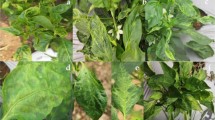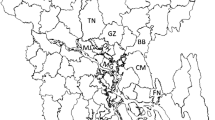Abstract
Natural occurrence of severe chlorotic mottle disease of carrot (Daucus carota) with a significant incidence was observed in northern Uttar Pradesh, India. The causal pathogen was successfully transmitted to a number of test plants through sap inoculations and by aphid (Aphis gossypii Glover). The association of Cucumber mosaic virus (CMV) was detected by reverse transcription-polymerase chain reaction (RT-PCR) and confirmed by sequencing of ~2.2 Kb amplicons. Analyses of sequence data (EU642567) revealed the presence of 2203 nucleotides of complete RNA3 which included two open reading frames (ORFs): movement protein (840 nucleotides translating 279 amino acid residues) and coat protein (657 nucleotides translating 218 amino acid residues). During BLAST analysis of complete RNA3 sequence, carrot virus isolate shared highest 97% identities with several strains of CMV of subgroup II reported worldwide. Phylogenetic analysis using RNA3 sequence data of selected strains of CMV of subgroup IA, IB and II showed the close relationship of carrot isolate with the strains of CMV of subgroup II. Based on highest sequence identities (97%) and close phylogenetic relationship, the causal virus of mottle disease in carrot was identified as an isolate of CMV belonging to subgroup II. The association of CMV of subgroup II with chlorotic mottle disease of D. carota is a first report from India.
Zusammenfassung
Im Norden des indischen Bundesstaates Uttar Pradesh wurden höhere Befallshäufigkeiten einer chlorotischen Sprenkelkrankheit der Möhre (Daucus carota) beobachtet. Der Erreger konnte durch mechanische Saftinokulation oder durch Blattläuse (Aphis gossypii Glover) auf verschiedene Testpflanzen übertragen werden. Die Reverse-Transkriptase-Polymerase-kettenreaktion (RT-PCR) zeigte eine Beteiligung des Gurken- mosaikvirus (CMV) an der Möhrenkrankheit, was durch die Sequenzierung eines ≈2.2 Kb großen Amplicons bestätigt wurde. Die Sequenzanalyse des Amplicons (EU642567) ergab 2203 Nukleotide der vollständigen RNA3 des CMV mit zwei offenen Leserahmen (ORFs), dem Transportprotein (840 Nukleotide, die 279 Aminosäuren kodieren) und dem Hüllprotein (657 Nukleotide und 218 Aminosäuren). Während der BLAST-Analyse der vollständigen RNA3-Sequenz zeigte das Virusisolat aus der Möhre die höchste Übereinstimmung (97%) mit verschiedenen Stämmen der Untergruppe II des CMV aus allen Erdteilen. Eine phylogenetische Analyse von RNA3-Sequenzdaten ausgewählter CMV-Stämme der Untergruppen IA, IB und II bestätigte die enge Beziehung zwischen dem indischen Möhrenisolat und den CMV-Stämmen der Untergruppe II. Aufgrund der 97%igen Sequenzübereinstimmung und der engen phylogenetischen Beziehung wurde der Erreger der chlorotischen Sprenkelkrankheit der Möhre als CMV-Isolat der Untergruppe II identifiziert. Es handelt sich um die erste Beschreibung des CMV der Untergruppe II als Erreger der chlorotischen Sprenkelkrankheit der Möhre in Indien.
Similar content being viewed by others
References
Deyong, Z., P. Willingmann, C. Heinze, G. Adam, M. Pfunder, B. Frey, J.E. Frey, 2005: Differentiation of Cucumber mosaic virus isolates by hybridization to oligonucleotides in a microarray format. J. Virol. Meth. 123, 101–108.
Dubey, V.K., Aminuddin, V.P. Singh, 2008: First report of a subgroup IA Cucumber mosaic virus isolate from gladiolus in India. Aust. Plant Dis. Notes 3, 35–37.
Francki, R.I.B., D.W. Mossop, T. Hatta, 1979: Cucumber mosaic virus. Cmi/Aab Descriptions of Plant Viruses. No. 213.
Howell, W.E., G.I. Mink, 1976: Carrot thin leaf potyvirus. First reported in Daucus carota; from Washington State, U.S.A. Phytopathology 66, 949.
KUMAR, S., 2008: Molecular characterization of Cucumoviruses causing severe mosaic and ringspot diseases in chrysanthemum and development of their management strategies. PhD Thesis, University of Lucknow.
Latham, L.J., R.A.C. Jones, 2004: Carrot virus Y symptoms, loss- es, incidence, epidemiology and control. Virus Res. 100, 89–99.
Mahinghara, B.K., A.K. Singh., V. Hallan, R. Ram, A.A. Zaidi, 2006: Analysis of the coat protein gene and untranslated region of RNA3 of Cucumber mosaic virus isolates infecting various Lilium species and hybrids: association of the isolate infecting Asiatic Hybrid lily with subgroup II. Ind. J. Virol. 17, S–50.
Morgenstern, B., 1999: DIALIGN 2: improvement of the segment-to-segment approach to multiple sequence alignment. Bioinformatics 15, 211–218.
Murant, A.F., P.M. Waterhouse, J.H. Raschké, D.J. Robinson, 1985: Carrot Red Leaf and Carrot Mottle Viruses. J. Gen. Virol. 66, 1575–1579.
Palukaitis, P., F. Garcia-Arenal, 2003: Cucumoviruses. Adv. Virus Res. 62, 241–323.
Perry, K.L., L. Zhang, P. Palukaitis, 1998: Amino acid exchange in the coat protein of cucumber mosaic virus differentially affects transmission by the aphids. Myzus persicae and Aphis gossypii. Virology 242, 204–210.
Roossinck, M.J., 2002: Evolutionary history of Cucumber mosaic virus deduced by phylogenetic analysis. J. Virol. 76, 3382–3387.
Roossinck, M.J., L. Zhang, K. Hellward, 1999: Rearrangement in the 5′ nontranslated region phylogenetic analysis of Cucumber mosaic virus RNA 3 indicate radial evolution of three subgroup. J. Virol. 76, 6752–6758.
Sidhu, A.S., 1998: Current status of vegetable research in India. World Conference on Horticultural Research held at Rome (Italy) by International Society of Horticultural Science. www.agrsci.unibo.it/wchr/wc2/asv.html.
Srivastava, A., S.K. Raj, 2004: High molecular similarity among Indian isolate of Cucumber mosaic virus suggests a common origin. Curr. Sci. 87, 1126–1131.
Stubbs, L.L., 1952: Carrot motley dwarf virus. Aust. J. Sci. Res. 5, 399.
Sudhakar, H., D.N. Prasad, N. Mohan, K. Murugesan, 2006: First report of CMV subgroup II infecting Lycopersicon esculentum in India. Plant Dis. 90, 1457.
Tamura, K., J. Dudley, M. Nei, S. Kumar, 2007: MEGA4: Molecular Evolutionary Genetics Analysis (MEGA) software version 4.0. Mol. Biol. Evol. 24, 1596–1599.
Verma, N., V.K. Mahinghara, R. Ram, A.A. Zaidi, 2006: Coat protein sequence shows that Cucumber mosaic virus isolate from geranium (Pelargonium spp.) belongs to subgroup II. J. Biosci. 31, 47–54.
Verma, N., A.K. Singh, L. Singh, G. Raikhy, S. Kulshrestha, M. Singh., V. Hallan, R. Ram, A.A. Zaidi, 2005b: Cucumber mosaic virus (CMV) infecting Alstroemeria hybrids in India. Aust. Plant Pathol. 34, 119–120.
Verma, N., L. Singh, A.K. Singh, S. Kulshrestha, G. Raikhy, V. Hallan, R. Ram, A.A. Zaidi, 2005a: Ornithogalum: a new host of Cucumber mosaic virus (CMV) from India. Plant Pathol. 54, 256.
Author information
Authors and Affiliations
Corresponding author
Rights and permissions
About this article
Cite this article
Afreen, B., Khan, A.A., Naqvi, Q.A. et al. Molecular identification of a Cucumber mosaic virus subgroup II isolate from carrot (Daucus carota) based on RNA3 genome sequence analyses. J Plant Dis Prot 116, 193–199 (2009). https://doi.org/10.1007/BF03356310
Received:
Accepted:
Published:
Issue Date:
DOI: https://doi.org/10.1007/BF03356310




